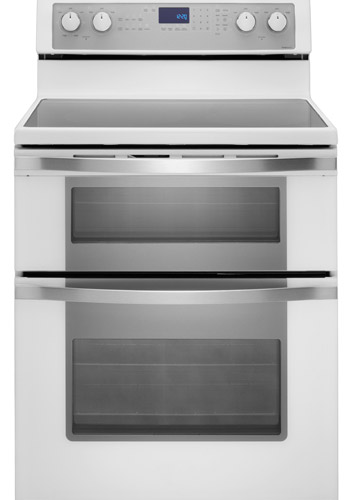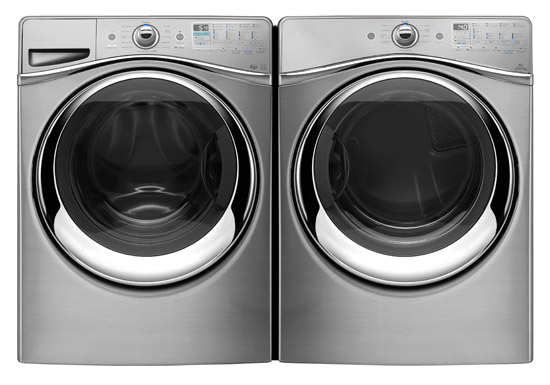Appliance Performance beyond ENERGY STAR®
Cooking Appliances
As mentioned previously, there are limited U.S. federal standards that apply to appliances or other products used for cooking which regulate standby power and prohibit a constantly operating pilot light for gas appliances. As a practical matter there are many variables that make developing meaningful standards a difficult process at best. For example, consider the variable amount of time that any given cooking appliance may actually be used during an average day. Nonetheless, appliance manufacturers have forged ahead with new technology which results in products that are achieving new levels of efficiency and performance.
 |
Double oven ranges provide smaller oven chambers requiring less energy to heat them up to temperature. Photo courtesy of Whirlpool Corporation |
One notable example is the use of electric induction cooking elements as an alternative to either traditional electric resistance or natural gas cooking. Induction elements are the newest and most innovative types of cook-tops since the induction elements transfer electromagnetic energy directly to the pan, where heat is needed, and not to the surrounding area. As a result, this type of cooking appliance is very energy efficient, using significantly less energy than radiant electric systems and has been calculated to provide even greater savings when compared to natural gas.
When it comes to ovens, certain free standing ranges are being built today with two oven cavities. This provides convenience in cases where two separate dishes are being cooked at the same time but which require different temperatures. However, it is also more energy efficient because the oven cavities are smaller than a comparable free standing range with just one oven cavity so each cavity requires less energy to heat up to temperature while heating up faster in the process. Models that provide a smaller top oven cavity, where a vast majority of meals could be cooked, use less energy than the traditional larger single cavities. Some self-cleaning ovens also have innovative coatings on the cavity wall which make it harder for soils to stick. That is coupled with temperature cleaning options at lower temperatures than the traditional self-clean cycle which essentially heats the oven up to such a high temperature that it burns all the soils off. Lower self cleaning temperatures translate to less energy used in the process.
Clothes Washers
On average, hot water heating accounts for about 90 percent of the energy consumed by a clothes washer – only about 10 percent of the energy goes to run the washer motor. Hence, clothes washer efficiency clearly needs to address both energy and hot water usage. One emergent trend for greater efficiency is to use horizontal axis (H-axis) or front loading washing machines which have been shown to use about half to a third of the energy of conventional vertical-axis top-loaders. The horizontal wash drum orientation fundamentally requires less energy and water to get the same load just as clean in part because the whole tub does not need to fill up to do the washing. They also use a faster spin speed than vertical axis machines allowing more water to drain out of the wet clothes such that they will require less drying energy as a result.
 |
Front loading, horizontal axis washers have demonstrated lower energy and water usage and can be readily paired with front loading dryers. Photo courtesy of Whirlpool Corporation |
Independent of machine style, selecting a model with many choices to control wash cycles and water temperature gives the owner more ability to reduce operational energy use. Generally, washing a full load is most efficient and capable of saving thousands of gallons of water each year. Nonetheless, controls should allow the option of using a smaller amount of water for small loads when needed.
Just like dishwashers and refrigerators, “smart” clothes washers that can connect to the smart grid are commercially available today. They offer the option to delay the start of the cleaning cycle to when prices are lowest (in time of use pricing zones) and can send notifications on when a load is complete, etc. Like dishwashers, certain clothes washers also sense the size and soiling level of the clothing load and adjust cycle parameters automatically to optimize resource efficiency. Some front loaders have a bulk dosing option, where the user will add a large amount of detergent into a special cartridge in the machine. The machine will then determine how much detergent is required based on the load conditions sensor thus avoiding human error in overdosing the load.
Clothes Dryers
The fundamental energy choice in clothes dryers is to select between electric and gas-fired models. In terms of comparative energy use, gas dryers are generally less expensive to operate however there is not a lot of variation in actual energy use between models for identical loads run for identical times. The main variables for determining the amount of energy used in dryers become the frequency of usage and the running time selected when they are used.
The operational energy use of a dryer is largely dictated by whether or not the dryer employs sensors to automatically turn off the dryer once clothes are dry. The alternative is timed drying which leaves the running time, and corresponding energy use, to the guesswork of the user. The best dryers have moisture sensors inside the drum for sensing clothing dryness and automatically shut the machine off when the clothes have dried. Most others only infer dryness by using temperature sensors in the exhaust air portion of the dryer, which may result in running the dryer longer than needed. Compared with timed drying, savings of about 10 percent with temperature-sensing controls and 15 percent with moisture-sensing controls are possible.
Like clothes washers there are “smart” grid compatible clothes dryers commercially available today. They offer the option to delay the start of the drying cycle to when prices are lowest and can also send consumers notification to their mobile device when their load is complete among other things. Almost all such connected appliances can report the real-time energy usage of the appliances as they are being used.
Currently, the ENERGY STAR® program does not rate clothes dryers, but that may be changing in the near future. Measurement tests and standards are being worked on to define a reliable means to measure and differentiate performance of clothes dryers.
Efficient Appliances in Green Homes
With an understanding of the energy efficiency of each of these major appliances, what is their impact on the design of green homes? Different green home rating systems look at this a little differently, so let’s take a brief look at each.









